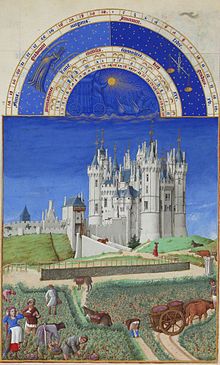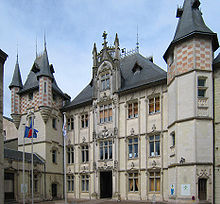Saumur
| Saumur | ||
|---|---|---|

|
|
|
| region | Pays de la Loire | |
| Department | Maine-et-Loire | |
| Arrondissement | Saumur | |
| Canton | Saumur (main town) | |
| Community association | Saumur Val de Loire | |
| Coordinates | 47 ° 16 ′ N , 0 ° 5 ′ W | |
| height | 20-95 m | |
| surface | 66.25 km 2 | |
| Residents | 26,734 (January 1, 2017) | |
| Population density | 404 inhabitants / km 2 | |
| Post Code | 49400 | |
| INSEE code | 49328 | |
| Website | www.ville-saumur.fr | |


Saumur [ somyʀ ] is a town with 26,734 inhabitants (at January 1, 2017) on the lower Loire in western France in the department of Maine-et-Loire in the region of Pays de la Loire . Saumur is the seat of the sub-prefecture for the Arrondissement of Saumur .
history
Prehistoric traces can be found in the north-west of Pierre Couverte du Mousseau .
Saumur was based on a castle from the 9th century. In 1026, Fulk Nerra , Count of Anjou , ended the rule of the Counts of Blois , and Saumur developed into an important trading post in the province. As part of the Anjou , Saumur became a French crown domain in 1204 under Philip II . In the 16th century, Heinrich III. the city to Henri de Navarre, later Henry IV. , from.
In the 16th century Saumur developed into the intellectual center of the Huguenots . A Protestant academy founded by Philippe Duplessis-Mornay in 1593 was dissolved as a result of the Edict of Fontainebleau in 1685. Moyse Amyraut , Louis Cappel and Franciscus Gomarus worked at the academy ; and François Turrettini and Jean Frédéric Ostervald studied here. The academy was closely connected to the triumvirate of Isaac Casaubon , Joseph Justus Scaliger and Claudius Salmasius , who were active in the Netherlands . Not only did the academy have to close, but the population also left the city, thus losing its economic foundation.
In 1848 the Tours – Saint-Nazaire railway reached the city.
Saumur is an important location for the French cavaliers and the seat of the French riding school Cadre Noir . Towards the end of the western campaign (May 10 - June 22, 1940), the island and the south bank were defended by a few hundred young cavalry cadets for two days from June 18, although the Compiègne armistice was imminent or agreed on June 19 had been. It was not signed until June 22, 1940, and on June 21, 1940 Saumur was captured by the 1st Cavalry Division of the Wehrmacht under Major General Kurt Feldt . Feldt was a horse connoisseur and lover. When the High Command of the Army (OKH) offered to support the attack on Saumur with dive bombers , he said: "Those over there are cavalrymen and therefore our friends - and besides, I am reluctant to let bombs destroy the beautiful horses." When Feldt died in 1970, French officers laid wreaths on his coffin.
Saumur was liberated by Allied tank troops under General George S. Patton in August 1944 . Patton had studied in Saumur in 1912 and had already commanded tanks in World War I. The Musée des Blindés, one of the largest tank museums in the world, has been located in Saumur since 1977 . It has u. a. the only roadworthy Tiger II "King Tiger" in the world.
economy
Today Saumur is the center of a wine-growing region with wine and sparkling wine cellars. Saumur is also a leader in the production and processing of mushrooms . Horticulture also plays a major role: 40 percent of the rose bushes produced in France come from the region. Other production sectors are aluminum parts, canned food, tobacco, liqueur and textiles. Tourism is becoming more and more important for the area around Saumur. The approximately 75 regional attractions attract a million visitors every year.
Saumur wine region
The wine region Saumur belongs to the wine region of Anjou-Saumur and vineyards of the Loire . A total of 36 municipalities have AOC Saumur status . In 2002, 138,900 hectoliters of wine were brought in on a total of 2,735 hectares . The vineyards are located on the slopes of the Loire and its tributary Thouet .
Saumur Mousseux
The sparkling wine is the most important wine in Saumur. Of the 138,900 hl of wine in Saumur, this alone accounted for 61,930 hl . The mostly reasonably priced wine is made from the grape varieties Chenin Blanc (as a leading vine), Chardonnay and Sauvignon Blanc . As in Champagne, the producer houses have cellars carved in stone. The tuff rock was very popular as a building material in the area. In recent years, many base wines have been used to produce the Crémant de Loire, which is easier to market internationally.
Saumur Blanc
The white wine is mainly from the grape variety Chenin Blanc grapes. The wine has a strong acidity and can therefore be quite long-lived. The vineyards in the municipalities of Turquant and Brézé have the best reputation.
Saumur Rouge
The red wine is made almost exclusively from the Cabernet Franc grape variety (which is called Breton here ). The varieties Cabernet Sauvignon and Pineau d'Aunis are also permitted . Wines from the municipalities of Puy-Notre-Dame , Montreuil-Bellay and Tourtenay have earned a good reputation.
Saumur-Champigny
The wine from this region was a fashion wine in the 1970s and 1980s. The red wine made from Cabernet Franc is light and fruity and is therefore sometimes referred to as the Beaujolais of the Loire . The vineyard area is approximately 1497 hectares (as of 2002). The area takes its name from the small community of Souzay-Champigny . The most important manufacturer is the Saint-Cyr-en-Bourg cooperative .
Coteaux-de-Saumur
Name for a white wine made from Chenin blanc. Is only produced in small quantities. The cultivation area is currently approx. 15 ha (amount 505 hl in 2002).
Attractions
- The municipality is part of the Loire-Anjou-Touraine Regional Nature Park .
- The best-known historical building is certainly Saumur Castle with a Gothic core (14th / 15th century) and Renaissance alterations (16th century).
- No less well known is the Romanesque church of Notre-Dame-de-Nantilly, the construction of which dates back to the 12th century.
- Below the castle is the largely Gothic Saint-Pierre church, construction of which also began in the 12th century.
- The old part of the town hall, which was once built into the city wall and located directly on the Loire, dates from the 15th century.
- Likewise, the old houses in the historic city center , u. a. Maison de la Reine de Sicile , from the 15th century.
- The historic cavalry school with the attached Cadre Noir emerged from the training and elite force of the French cavalry at the end of the 18th century. Today the institute is dedicated to the French equestrian tradition as well as modern sport equestrianism.
- The city's museums include the Musée des Blindés, one of the largest tank museums in the world, a horse museum and a mushroom museum.
- In the vicinity of Saumur, the path to the cave village of Les Perrières and the dolmen of Bagneux is worthwhile .
Culture
music
- After the French hard rock band Trust was banned from performing in Saumur in 1980 , this group released a track called Saumur on their second album Répression , the text of which is unflattering for the city.
- The French ska rock band La Ruda was founded in Saumur in 1993.
Town twinning
Saumur maintains town twinning with
- Verden in Lower Saxony , Germany
- Warwick in Warwickshire , United Kingdom
Friendship contracts exist with
- Havelberg in Saxony-Anhalt , Germany
- Asheville in North Carolina , USA
Further connections exist to
- Emmerich am Rhein in North Rhine-Westphalia , Germany: the Saumur-College Honoré de Balzac is a partner school of the Willibrord-Gymnasium
Personalities
- Moyse Amyraut (1596–1664), Protestant Reformed pastor and professor of theology in Saumur
- Fanny Ardant (born 1949), actress
- Charles Beulé (1826–1874), archaeologist and politician
- Jean de La Brète (1858–1945), writer
- Eugène Bonnemère (1813-1893), writer and historian
- François Bontemps (1753–1811), infantry general
- Louis Cappel (1585–1658), Reformed theologian from France
- Coco Chanel (1883–1971), 20th century fashion designer and founder of the Chanel fashion empire
- Jeanne Delanoue (1666–1736), founder of the French order and is a saint of the Catholic Church
- Joseph Francois Foullon (1715–1789), general, one of the first prominent casualties of the French Revolution
- Emmanuel Gobilliard (* 1968), Catholic clergyman, auxiliary bishop in Lyon
- Franciscus Gomarus (1563–1641), Reformed theology professor 1615–1618 in Saumur
- Pierre Goubert (1915–2012), historian
- Louis Lemoine (1754-1842), General
- Marie Adrien Persac (1823–1873), painter, cartographer and photographer
- Dominique Pinon (* 1955), film actor
- Joseph Louis Proust (1754-1826), chemist
- Yves Robert (1920–2002), actor and director
Others
The Cadre Noir in Saumur is the most famous French riding school.
literature
- Le Patrimoine des Communes de Maine-et-Loire . Flohic Editions, Volume 2, Paris 2001, ISBN 2-84234-117-1 , pp. 1144-1176.
Web links
- Monuments historiques (structures) in Saumur in the Base Mérimée of the French Ministry of Culture
- Monuments historiques (objects) in Saumur in the base Palissy of the French Ministry of Culture
- Official website of the city of Saumur (French)
- Official website of the Saumur Tourist Office (French)
Individual evidence
- ↑ Lyrics in French .
- ↑ La Ruda .




